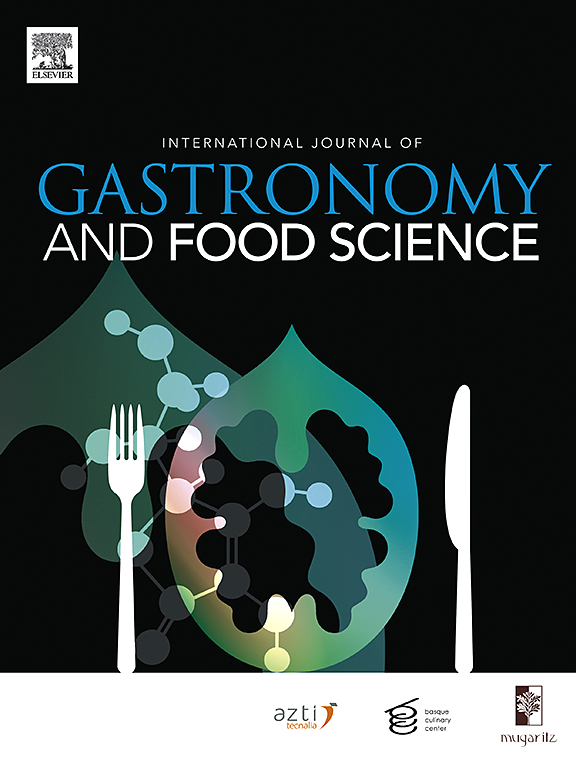Artichoke leaf extract powder: Sustainable production and potential culinary applications
IF 3.2
2区 农林科学
Q2 FOOD SCIENCE & TECHNOLOGY
International Journal of Gastronomy and Food Science
Pub Date : 2025-01-17
DOI:10.1016/j.ijgfs.2025.101113
引用次数: 0
Abstract
In this study, artichoke leaves were processed into a value-added powder by freezedrying method. Some physical and chemical properties of this powder were determined. Its potential for use in gastronomy was also investigated. The soft inner part of the artichoke leaf was mechanically separated from the hard shell, heat treated, pressed and the water-soluble part of the leaf was obtained as an extract. The extract was then freeze-dried to obtain artichoke leaf extract powder. The moisture content (8.59 ± 0.10, % by mass) and water activity (0.388 ± 0.003) values suggested that the powder does not support microbial growth. The product is yellowish and possesses a medium level of brightness, with an average particle size of 198 μm. The high contents of inulin (47.8 ± 0.5 g/100g), antioxidant capacity (33.1 ± 0.6 μmol/g) and total phenol content (51.5 ± 1.1 mg/g) demonstrates the health-promoting attributes. The artichoke leaf extract powder was incorporated into rice pilaf at 1% and 3% levels, by mass (g powder:g rice × 100) and butter (3%, by mass) and the samples were evaluated sensorially by a pilot consumer panel, and the appreciation level of the samples was found to be high.
求助全文
约1分钟内获得全文
求助全文
来源期刊

International Journal of Gastronomy and Food Science
Social Sciences-Cultural Studies
CiteScore
5.30
自引率
10.50%
发文量
170
审稿时长
45 days
期刊介绍:
International Journal of Gastronomy and Food Science is a peer-reviewed journal that explicitly focuses on the interface of food science and gastronomy. Articles focusing only on food science will not be considered. This journal equally encourages both scientists and chefs to publish original scientific papers, review articles and original culinary works. We seek articles with clear evidence of this interaction. From a scientific perspective, this publication aims to become the home for research from the whole community of food science and gastronomy.
IJGFS explores all aspects related to the growing field of the interaction of gastronomy and food science, in areas such as food chemistry, food technology and culinary techniques, food microbiology, genetics, sensory science, neuroscience, psychology, culinary concepts, culinary trends, and gastronomic experience (all the elements that contribute to the appreciation and enjoyment of the meal. Also relevant is research on science-based educational programs in gastronomy, anthropology, gastronomic history and food sociology. All these areas of knowledge are crucial to gastronomy, as they contribute to a better understanding of this broad term and its practical implications for science and society.
 求助内容:
求助内容: 应助结果提醒方式:
应助结果提醒方式:


